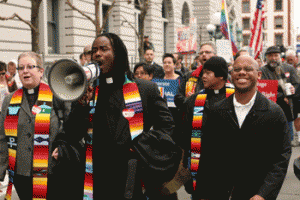If they'd written an opinion that struck down bans on gay marriage not just in California but in all the states covered by the 9th Circuit, the Supreme Court would almost have to step in to resolve the matter one way or the other, because you would have had a very different federal rights regime west of the Rockies vs. the rest of country.
But by limiting the ruling and the reasoning to California and to Proposition 8, the Ninth Circuit judges at least give the Supreme Court an excuse not to step in.
Today's ruling is monumental in a lot of respects: This is the first federal appellate ruling that holds there is a federal right to same-sex marriage, no matter how narrow the reasoning might be. That alone coupled with California's size and prominence may lead the Supreme Court to feel they have to weigh in. But as important as California is, it's still one state. If the decision had affected nine states rather than one, it would have been bigger still.
But there was no way the 9th circuit was going to rule for the plaintiffs and not create a significant risk that the Supreme Court would step in. The question wasn't whether the Supreme Court had its eye on this case, the question was how do you minimize that, and I think they tried to do that by keeping the reasoning specific to California.
That may not work. The Prop 8 proponents may end up convincing the Supreme Court that this is a big ruling that needs to be dealt with, even though it affects California only.
In terms of dissent from Judge Smith, who said he isn't convinced there isn't a rational reason to limit marriage to heterosexuals, what impact might that have on the Supreme Court or on a possible Ninth Circuit en banc panel?
I'm not sure the dissent is going to influence many people on the Ninth Circuit or on the Supreme Court. This matter is important and has been in the news so much that a lot of judges on both courts probably have their own views.
And a lot of people who might agree with Judge Smith that Prop 8 is not unconstitutional would have written a very different dissent, stressing different issues. Judge Smith stressed procreation and child rearing, other people might stress how it should be permissible for states to proceed incrementally and with caution, and that you don't want too much social change too quickly. For some backers of same-sex marriage, that's a more plausible line of defense.
So I'm not sure the particulars of what Judge Smith said in his defense will affect anybody, but it is a reminder that this is the kind of dispute where you're unlikely to have unanimity on any court.
Washington state may soon legalize gay marriage. The senate has passed it; the governor says she'll sign it. What effect does the politics of same-sex marriage have on the ultimate resolution of this case legally?
I think that the larger political backdrop has an enormous effect. Whether the Supreme Court always admits it or not –- and sometimes they do —- federal constitutional rights are easier to defend when there is a broad or emerging national consensus on them.
This is not to say that minorities should be deprived of their basic liberties simply because they haven't convinced the entire country that they're being treated unfairly. But when you do have social movements that reflect a broader national trend line, there are justices on the Supreme Court who will feel more comfortable saying what was a regional trend is now national, so they will feel more disposed to deem it a national right.
For Justice Kennedy, for instance, to embrace gay marriage as a federal right when five states or seven states have recognized it is different than if a dozen or 20 states have.
One area in which the Supreme Court does this explicitly is the Cruel and Unusual punishment clause of the 8th Amendment. What counts as cruel and unusual depends on how many states do the same thing.
In the most famous Supreme Court same-sex case to date, Lawrence vs. Texas, in which the court struck down a law that made it a crime to engage in any same-sex conduct, I think it mattered a great deal that Texas was an outlier.
There's a famous case from Colorado that Judge Reinhardt leaned on in his opinion today, Romer v. Evans, where the Supreme Court struck down a mean-spirited measure in Colorado that visited discrimination on gays and lesbians. In Justice Kennedy invalidating that measure, he highlighted that Colorado was an outlier, was doing something unusual.
So the more states that recognize same-sex marriage and the more that becomes the trend line, the more that those states who don't recognize it start to look like laggards.
Thinking back to Brown v. Board of Ed on segregation and Loving v. Virginia on interracial marriage, how would you compare the public mood about those issues versus the way the public feels now about gay marriage?
I think it mattered a lot in Loving v. Virginia that a lot of states in the years leading up to 1967 had become more liberal with respect to interracial marriage.
The California Supreme Court recognized interracial marriage decades before the Supreme Court in Loving, but in that intervening period a number of other states followed California's lead. So by the time the Supreme Court determined interracial marriage to be a national right in 1967, the trend line was clear and states that resisted begun to look like outliers. Brown vs. Board of Ed is a little different because you still had a big bloc of states that were adamant in not wanting to desegregate, so that was more regionalized.
